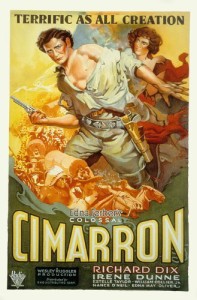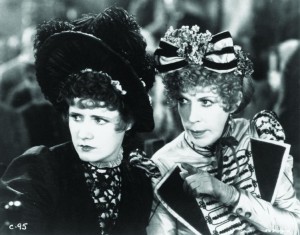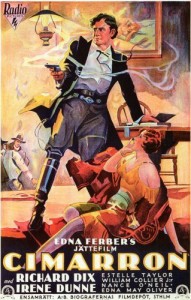Cimarron **** (1931, Richard Dix, Irene Dunne, Estelle Taylor, Edna May Oliver) – Classic Movie Review 2326
Director Wesley Ruggles’s creaky but still rewarding 1931 Western film Cimarron is a triple Oscar-winner for Best Picture, as well as Best Adapted Screenplay (Howard Estabrook) and Art Direction (Max Rée). It is remarkable as the only Western to win the Best Picture Oscar till Dances with Wolves in 1990, after a 59-year gap.
Cimarron was the first Western to win a Best Picture Oscar or any Oscar. Also it was the first film to be nominated for every major Academy Award or to receive more than six Oscar nominations.
Based on Edna Ferber’s novel, the plot is about the Western lives of an Oklahoma family in the period up to the First World War. The movie was a very big deal in its day, though alas, given its technical limitations as an early talkie, it hasn’t worn terribly well.
The silent-film-style overacting of the chunky, hard-set star Richard Dix also tends to make it a little hard to watch. But it’s still well worth the effort that it takes to view it thanks to several other outstanding assets, among them Ferber’s story, co-star Irene Dunne’s feisty performance, the spectacular opening land-rush sequence filmed on location with a vast cast, Edward Cronjager’s eye-catching cinematography, Max Steiner’s thumping music score and the RKO Pictures studio’s costly, ambitious production on a huge scale.
Richard Dix plays newspaper editor Yancey Cravat, who settles in an Oklahoma boom town with his reluctant wife Sabra at the end of the nineteenth century. Irene Dunne shines in her second film as Dix’s bride.
Cravat is based on real-life lawyer and gunfighter Temple Houston – the son of Sam Houston, whom Dix played in Man of Conquest (1939) and on whom the 1960s Western TV series Temple Houston is based.
RKO’s most expensive film until Gunga Din (1939), Cimarron received excellent critical reviews, but it lost money on its initial release during one of the darkest periods of the Great Depression. It is thought to be the only Best Picture Oscar-winner to lose money during its initial release. It was the only RKO-produced film to win the Best Picture Oscar. RKO paid a then-record $125,000 for the film rights to the novel, helping to take the budget to $1,433,000. The film lost $565,000 on first release, but went into profit when re-released in 1935.
Cimarron was also Oscar nominated for Best Actor (Dix), Best Actress (Dunne), Best Director and Best Cinematography (Edward Cronjager). The land rush sequence took a week to film, using 5,000 extras, 28 cameramen, six still photographers and 27 camera assistants.
Also in the cast are Estelle Taylor, Nance O’Neil, William Collier Jnr, Roscoe Ates, Edna May Oliver, Stanley Fields and George E Stone. Nino Cochise, the grandson of the Chiricahua chief Cochise, and his friend Apache Bill Russell are among the extras.
Edna Ferber (1887-1968) is known for her work on Stage Door (1937), Show Boat (1951) and especially Giant (1956).
Dunne was put under contract to RKO Pictures in 1930. Her first film was Leathernecking (1930). Cimarron was the first of her five Academy Award nominations, but she never won an Oscar, not even an honorary award. The others are Theodora Goes Wild (1936), The Awful Truth (1937), Love Affair (1939) and I Remember Mama (1948).
Cimarron is a river 600 miles long that rises in northeastern New Mexico and flows eastward into Oklahoma where it becomes a tributary of the Arkansas River.
Cimarron was remade in 1960 as Cimarron with Glenn Ford, Maria Schell and Anne Baxter.
© Derek Winnert 2015 Classic Movie Review 2326
Check out more reviews on http://derekwinnert.com








